Student Spotlight: Embedded with Mariachi Vargas
Editor’s note: As part of the UMS 21st Century Artist Internships program, four students interned for a minimum of five weeks with a dance, theater, or music ensemble part of our 2015-2016 season. Christina Maxwell is one of these students. This summer, she was embedded with the Mariachi Vargas de Tecalitlán.
Below, Christina shares her travel stories in advance of their return Ann Arbor on April 1, 2015.
As the plane prepares for takeoff, I put down the notebook of Spanish verb conjugations I’ve been feverishly trying to memorize. I found out only a week ago that I’d been selected to spend the summer working with Mariachi Vargas de Tecalitlán, the world’s premier Mariachi group based out of Mexico. So only a few days and 150 pounds of luggage later, I’m on my way to San Antonio, Texas.
Mariachi Vargas was founded in 1897 in Jalisco, Mexico and consists of 13 electrically dynamic men on vocals, guitar, guitarrón, violin, vihuela, trumpet, and harp. I will work with Muñoz Public Relations, the agency that will present Mariachi Vargas in Ann Arbor in April. I wonder what in the world I, a Southern, white Musical Theatre major and writing minor with a minimal Spanish vocabulary and almost no exposure to Mariachi music, am doing on this airplane. For me, and perhaps for many readers here on UMS Lobby, my only exposure to Mariachi Music has been the familiar selections that might be heard at a Mexican restaurant.
What did I have to offer to these people? A million doubts materialized as the barometric pressure rose, and as San Antonio and the hazy world of Mariachi Music crept closer. This is when I remind myself that that feeling of free-falling, of having no idea what lies ahead or whether I have what it takes to embrace it, usually comes before the greatest adventures. And a great adventure it was.
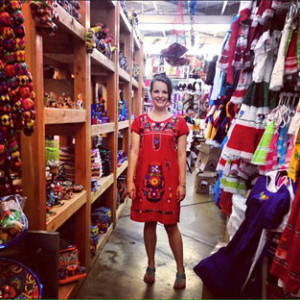
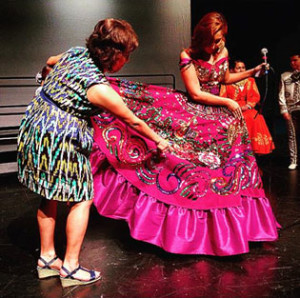
On left, the traditional huipil I bought in the San Antonio Market Square. On right, Cynthia shows the intricate details of a student’s dress during a traje presentation (the traditional attire for Mariachi singers).
Settling into San Antonio
I remember this summer as an explosion of color, flavor, and sound. There is nothing black-and-white about the world of Mariachi Music and the Mexicano community that embraces it as lifeblood. The crowded streets of the San Antonio Market Square are flooded with vibrant fabrics and rich fragrances drifting from street food stands selling elotes (roasted corn), mangonadas (a Mexican fruit drink), and fresh fruit with lime and chili powder. Rainbows of dazzling sequins and threads decorate the intricate and costly trajes and sombreros of the Mariachi performers. Even sunlight seems more alive as it sparkles through the stained glass windows of the nearby ancient Espada Mission. Everything is full of rhythm and life and everything is done to the fullest…whether that’s mourning heartache, celebrating with tequila, or extending hospitality.
The Mariachi community did not merely accept me. They welcomed me, a stranger, into their world with open arms. I worked for Cynthia Muñoz, a brilliant woman who runs her own agency, Muñoz Public Relations, with her sister, Sandra Guevara. A savvy, creative and passionate businesswoman, Cynthia landed the coveted Ford Motor Company account in 1992. Cynthia has combined her brilliant business sense with her long-time love for Mariachi music to resurrect and preserve the tradition of Mariachi music in San Antonio.
She produces concerts in the US by the world-renowned group Mariachi Vargas de Tecalitlán (like their upcoming April performance in Hill Auditorium in Ann Arbor, Michigan). In 1995, she began the Mariachi Vargas Extravaganza, the longest-running Mariachi music festival in Texas. The festival is a bedrock for cultural diversity in the arts, and for the importance of education in the Mexican American community. It’s become an integral part of the San Antonio community, which is part of the reason why Cynthia was recently awarded the San Antonio Business Journal’s “Woman of the Year” award.
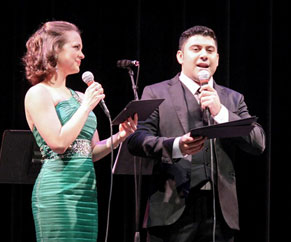
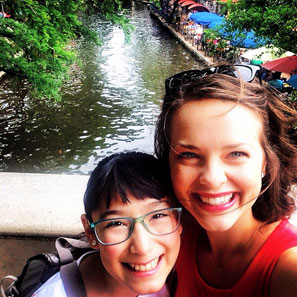
On left, with my fellow emcee Elio Iniguez during the Serenata Para Las. Madres. When we were offstage, Elio translated every word of the music for me so I could truly understand it. On right, enjoying the famous River Walk with the extraordinarily talented and bilingual Angelica Vargas.
Settling into the internship
I watched Cynthia network with ease and acumen, garner the attention of the press with persistence and a personal touch, and whip up a perfectly worded and irresistible corporate sponsorship package in the middle of the night over ice cream sundaes. She entrusted me with a full gamut of tasks, from writing and submitting press releases to finding and contacting booking houses across the country. In my first week in San Antonio, I worked to help Cynthia produce, execute, stage, organize, market and even emcee Serenata Para Las Madres, a Mother’s Day event in a beautiful old theater in downtown San Antonio. I also worked extensively with and accompanied Angelica Vargas, a young star from Mexico.
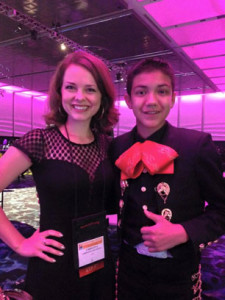
Photo: With Sebastian de la Cruz at La Raza. Sebastian performed with Mariachi Vargas de Tecalitlán the first time they visited Ann Arbor, Michigan. Most recently, ESPN did a special documentary on Sebastian, produced and directed by Eva Longoria. He was also featured on an episode of The Bachelor this summer, which we all watched from San Antonio!
Even after my internship ended, Cynthia hired me to help produce a high-profile event in Kansas City for La Raza, the largest Spanish convention in the country which features guest speakers like Hilary Clinton. I worked sound, lights, production and talent management under the highest of stakes for a concert featuring Pedro Fernandez, perhaps the most famous star of Mexico. I spent time with some of the hottest young talent, including Sebastian de la Cruz, an immensely talented Mexican-American San Antonio native. Sebastian is famous for competing on America’s Got Talent and for weathering racist remarks with class and bravery when he sang the National Anthem at an NBA Finals game at only eleven. The range of experiences she gave me was truly remarkable.
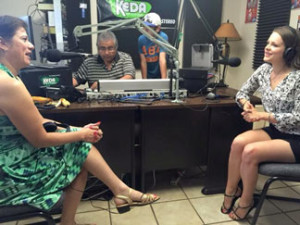
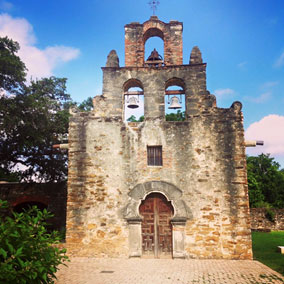
On left, sharing my experiences as a gringa in San Antonio on Cynthia’s morning talk show on KEDA Radio. My family from all over the South was able to tune in and listen! On right, the hauntingly beautiful Mission San Fransisco de la Espada, built in 1690, is one of the many missions Cynthia and I cycled to. The San Antonio missions were declared a World Heritage Sight while I was there this summer.
Living and working to the fullest
With true Mariachi hospitality, Cynthia welcomed me, a complete stranger, into her home for the duration of my stay. She lives with an ever-fluctuating balance between work and play, working when and how she wants and enjoying each day to the fullest. Each morning, we woke, ate a fresh and flavorful home-cooked breakfast, found a trendy local coffee shop to try, cycled for two hours along the River Walk or on the Mission Trail through the morning sunlight, and then come back to work late into the night. We’d finish the day with several episodes of Pablo Escobar, a Spanish novella-style series about the infamous Columbian drug lord, complete with subtitles to help me with my Spanish.
Cynthia’s sister, Sandra, is the tireless force that keeps the operation running. She’s a stickler for details and an expert in logistics, scheduling, and where to find the best piña coladas. Sandra taught me how to chase down bicycle street vendors for a pelota (a delicious popsicle with fruit and condensed milk), to manage the logistics for events with swarms of children, and to rally for all-nighters of celebrating with the members of Mariachi Vargas, playing music, laughing and telling stories into the early morning. Their entire family and business welcomed me into the fold, each teaching me something different. Sandra’s son, Javier, visited from New York and showed me around San Antonio from the eyes of someone close to my age, exposing me to San Antionio’s best sushi and to the view of Mariachi Music from behind his camera lens. I became dear friends with a fellow intern, Samantha, through our shared love for music, late nights talking, and shopping for turquoise in the downtown market. A former employee and family friend Laura and I bonded instantly over the chaos of working backstage and the beauty and intrigue of the Mariachi world. And Cynthia’s niece Haidyshared margaritas with me, helped me with my Spanish, and offered hilarious insider details to the Mariachi world. I found myself so quickly surrounded by new friends who I truly believe I’ll always stay in touch with.
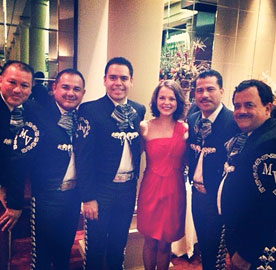
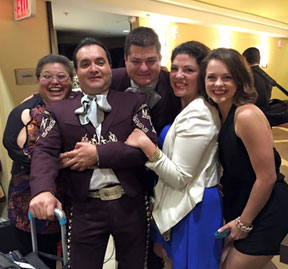
On left, meeting members of Mariachi Vargas for the first time after seeing them perform in the new opera, El Pasado Nunca Se Termina, at the Houston Grand Opera. On right, with Sandra and their employee and my new friend, Laura, welcoming members of Mariachi Vargas back after their phenomenal performance in Albuquerque, New Mexico.
Preparing for vocal camp
For the majority of the summer, I worked with Cynthia, Sandra, and other interns and staff members to prepare for the annual Mariachi Extravaganza Summer Vocal Camp. Nearly sixty of the most promising young Mariachi artists ranging in ages from 10 to 18 came to San Antonio from 20 cities across the US to work with extraordinary teachers to perfect their technique and stage presence. I helped to prepare the camp and knew everything about the students before they arrived, having created orientation packets and curriculum guides, arranged schedules for instructors, and sent numerous press releases.
Little did I know that I had much more than behind-the-scenes work in store. Cynthia asked me to workshop stage presence and confidence with the kids (she knew about my Musical Theatre background and had seen several videos of my performances). This was meant to happen after I observed the other instructors. On the way to camp the first day, she said, “Oh, by the way, two of today’s guest instructors can’t make it. You’ll have the 60 kids for two hours. Can you handle that?” Inside I panicked, thinking, “You’re kidding right?” But I smiled and heard myself say, “Ya, no problem!”
As looked at these 60 adorable and insanely talented kids, I felt the same doubt I had felt on the airplane. Yet, after the first student sang, I knew how much we all had in common. We all loved getting inside a song as a vehicle for the things we can’t put words to. We shared a deep respect for the history and integrity of music and for understanding where it comes from. I saw in those kids a hunger to learn, to grow and to better understand…the same exact thing I feel in myself every day as a student at the University of Michigan.
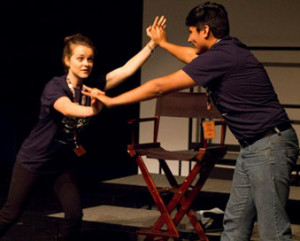
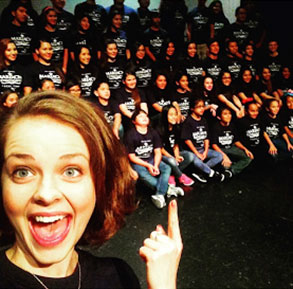
On left, working on confidence-building exercises with a student. On right, selfie time with 60 of the most talented and eager children I’ve met!
Singing in color
So, I stole from one of my favorite professors at the University of Michigan and taught them what I’d learned in a class called “Sophomore Performance.” How to truly communicate. The students wrote lyrics as a way to communicate with someone they knew, a conversation. We played silly games to loosen up and engage our bodies. We talked to each other as scene partners. They said their names about a zillion times until they could do it with confidence, clarity, and pride.
I watched the students learn with remarkable speed, excitement, and dedication. I saw light bulbs come on as they worked on communicating the high-stakes meaning of a song. I found myself loving teaching! One student jumped up and down after his individual lesson and said, “Woah. I’m gonna cry! Like when you were talking to me, I was so connected that I could feel it.” Another finished her heartbreaking rendition of a song after I worked with her and said, “I feel like everything just changed for me. Like my whole life I’ve been singing in black and white and suddenly I’m singing in color.”
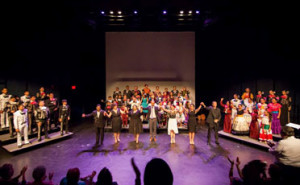
Taking a final bow with students and instructors, including Octavio Moreno, Vanessa Cerda Alonzo, and fellow intern and dear friend, Samantha Arizpe.
Taking a final bow with students and instructors, including immensely talented and beloved Octavio Moreno, Vanessa Cerda Alonzo, Rene Benavidez, and fellow intern and dear friend, Samantha Arizpe.
I can’t explain the pride and love I felt for my students as I watched them bare their souls through song, dressed in stunning traditional trajes. One of our students who had struggled to say his name with confidence at the beginning but who delivered such a powerful performance hugged me so tightly after the recital that I could hardly breathe. He said over and over, “Thank you, miss! Thank you, miss! Please don’t leave us! You’ll never understand what you’ve done for me!”
But the truth is, they’d done so much for me. They’d helped me to truly understand how deeply Mariachi music can move someone. They’d explained what Mariachi music means to them, how it “felt like freedom” or that it was like “when you have something stuck deep inside of you, and then you sing, and you can let it out.” Mariachi is something “the whole world should know about, so that they can love it, too.” I watched what these little Mariachi singers did for the people in the audience. I saw as these children’s families beamed with pride and cried out of love as they saw their children pour their hearts out through the musical tradition that had fed their own souls and the souls of their parents and grandparents and great grandparents for decades.

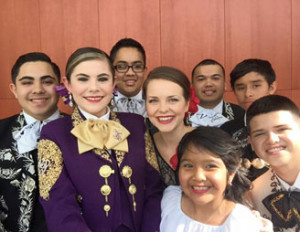
On left, at Cynthia’s request, I sang “Over the Rainbow” at the end of the recital as a way of sharing my own music from the world I come from. On right, with a group of the students, celebrating their success throughout the week!
“Have you ever seen people watch Mariachi Vargas perform? Look at them and then you will understand.”
But teaching was not without difficulty. There were times when I wasn’t sure what my role was or whether my advice was clashing with the form of music I was still learning about. At one point, Mr. Muñoz, Cynthia’s father, and her aunt pulled me aside after I worked with one of the students on how to push through the emotion of a song so that you don’t get too choked up to sing it. They said, “We think what you said to her isn’t right. You are here to teach, but you are also here to learn. And you don’t understand our world yet. What she did, she moved us so deeply because the people of our generation, we feel it. It’s when we see her cry that we break too.” At first, my heart sank. The last thing I wanted to do was to show ignorance, disrespect, or distaste for the culture and tradition. They continued, “Have you ever seen people watch Mariachi Vargas perform? Look at them and then you will understand.”
So when I went to Albuquerque, New Mexico with Cynthia, Sandra and close friend and co-worker Laura for a huge Mariachi Vargas concert, I did just that.
I sat in the middle of the Albuquerque, New Mexico mountains and watched the world’s three greatest Mariachi groups perform back to back, with Mariachi Vargas de Tecalitlán as the finale. I was completely captivated and breathless from the roller coaster of emotions I felt (during music that was not even in my own language!) The sky faded from blue to warm orange, red and purple, to deep black. Dust and strings flew from passionately flying guitar bows and bellows, cries, whispers and sighs cut from the mouths of the passionate performers straight to my soul. I sat captivated by their electric performance, a performance that used century-old music in a language I only intermittently understood to fill me with joy, mourning, longing, and celebratory abandonment.
When Mariachi Vargas de Tecalitlán began to play, I watched as the people around me cheered, held each other and mouthed the words along with them, as if the lyrics and the notes poured from a deep place within their souls, a place that we normally don’t bare. Mariachi music has a way of going to those places and living in them, awakening feelings that maybe we don’t often allow ourselves to feel. People were so moved that they wept openly. When the concert ended, I picked my phone up again for the first time since the concert began and realized that the concert had lasted five hours. I hadn’t considered that passage of time, or anything else outside of the performance.
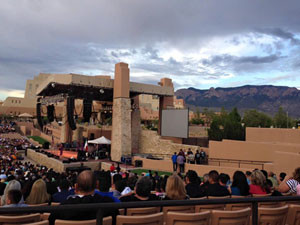
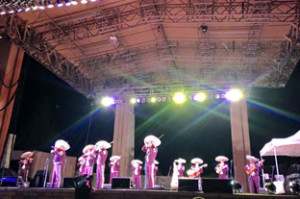
On left, getting ready for the concert to begin in Albuquerque! A breathtaking venue. On right, Mariachi Vargas take the stage!In video below, singing “Besame Mucho.”
When I think of that moment and compare it with what so many of us perceive Mariachi music to be, I realize what a chasm there is between the two. I saw the same reverence for the music when I learned “Besame Mucho,” a beautiful song in Spanish, and had the opportunity to work with Rigoberto Alfaro, a member and arranger for Mariachi Vargas for 13 years, and also one of the most instrumental figures in the history of Mariachi music. He offered to “lesson me,” to share his wisdom with me. As he played the guitar, I sang “Besame Mucho” while he motioned for me to give it more passion and instructed me to “sing it as I feel it.” That is where it comes from. It’s not about performing, it’s about understanding the depth and history of what you’re singing and allowing the feeling to sweep you along.
During the performance in Albuquerque, Mariachi Vargas member, José “Pepe” Martínez Jr. went into the crowd to serenade a few ladies, and I was lucky enough to make the cut.
Understanding the depth of history
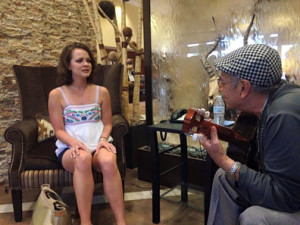
Working with the maestro himself, Rigoberto Alfonso. I still can’t believe I had the opportunity to be coached by the master himself!
I finally understood. And I wanted to learn more from the generation of people who so deeply valued and fiercely guarded the history of the music. So I listened to old recordings of the classics, listened to Cynthia’s friend, Rene, played the guitar with devotion, talked with reverence about Mariachi music, and observed the brilliant instruction, performances and meticulous dedication and heart of my extraordinary fellow instructors, Octavio Moreno and Vanessa Cerda Alonzo. I spent many hours at the home of Cynthia’s parents, sharing meals, black-and-white photos, and taking cooking lessons with her mother. One night, I went to just listen. I sat down with Mr. Muñoz and listened as he told me about his life, about the world he came from. He sat with his hands folded, proudly wearing a Korean War Veteran hat. I watched the deep lines in his face move as he told me about the tiny town in Texas where he grew up. It was so deeply segregated that the people, the whites and then the “Mexicans,” were divided in homes on opposite sides of the railroad tracks that ran through the town. He went to a completely segregated school for “Mexicans” (even though they were Mexican Americans) where the children spoke little or no English and the teachers spoke no Spanish. He explained to me that people of my generation don’t understand because we didn’t face what he did…the discrimination and the insurmountable odds.
I could not imagine his world of struggle until he told me one story in particular. Nearly fifty years ago, he and his brother loaded up their two station wagons with their wives and little kids to drive to Florida. They had been driving all day long when they stopped in Mississippi to find a place to rest for the night. The first place they went to, they were told there were no vacancies. They started again. The second one, the third one, the fourth one…the same thing happened. They came to the fifth place, and Mr. Muñoz stopped the owner before he could answer. He said, “Please don’t tell me you have no vacancy.” I waited quietly as he paused to clear his throat and regain composure. He continued, “My brother and I were standing there…we had to do that in front of our families?” This final man at the fifth place did welcome them and apologized for what the four other places had done. “You see, those are just minor things that our people have gone through.”
But when he talks about how proud he is of what his kids, Cynthia and Sandra, have done and of all he hopes for his grandchildren, the light returns to his eyes. He talks about how education is the way forward, the only way to move on. As he talks about music. I think of the students I taught. “Music is not something we hear for entertainment. This type of music or cohunta music or even guitar music…it’s our life, it’s part of our life, part of our existence.”
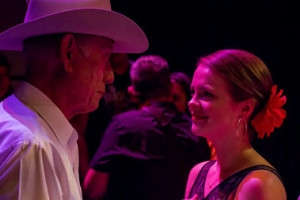
A final moment with Mr. Muñoz. Here, he told me I was now a part of the Mariachi Family.
Now, I’m not the same girl who boarded that airplane to San Antonio. This girl knows how to say “adios” with the correct nuance that makes you sound like a local rather than a gringa. I know how to cook traditional chicken mole and how to do the steps to the meringue dance.
Most importantly, I know that Mariachi music is a rich, vibrant, and thriving art form that cannot be fully understood until you see the faces of the people in the audience, the way they fill up with the celebration, love, and pain found in the songs themselves, the feelings that have poured into Mariachi music for over a century. This girl needed to learn these things, to go from that feeling of free-falling to that feeling of belonging to a new family, a Mariachi family. In my final conversation with Mr. Muñoz, he told me that Cynthia needed me… just the way that I came to San Antonio because I needed Cynthia. He was right. I needed to learn. Not only to sing, to mourn, to celebrate, to listen… but to live.
The Mariachi Vargas de Tecalitlán return to Ann Arbor April 1, 2015
Interested in more? Explore our photo and audio tour of Detroit’s Mexican Town.
Explore: Connections Between UMS and U-M Museum of Art
Visual and performing arts have a close relationship. We asked our partners and friends at UMMA (U-M Museum of Art) to link performances on the UMS season with visual art works that are part of the museum’s permanent collection.
Related performance: Tanya Tagaq in concert with Nanook of the North
February 6, 2016
 Artwork: Kenojuak Ashevak (Canadian, 1927-2013). Sun Owl, 1963. Stonecut print on paper. Gift of Mr. and Mrs. Eugene B. Power, 1964/2.103
Artwork: Kenojuak Ashevak (Canadian, 1927-2013). Sun Owl, 1963. Stonecut print on paper. Gift of Mr. and Mrs. Eugene B. Power, 1964/2.103
Like Tanya Tagaq, Kenojuak Ashevak was from Nunavut and her art was inspired by her Inuit experience. She often depicted animals from the Arctic such as this owl, but, also like Tagaq, she relies on her creativity and imagination. Ashevak explained that she drew as she thought, and so she produced spontaneous and improvisatory images.
Related performance: Camille A. Brown & Dancers: Black Girl — A Linguistic Play
February 13, 2016
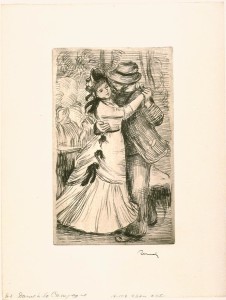 Artwork: Pierre Auguste Renoir (French, 1841-1919). Dance in the Country, c. 1890
Artwork: Pierre Auguste Renoir (French, 1841-1919). Dance in the Country, c. 1890
Soft-ground etching on paper. Museum Purchase, 1959/1.102
In Renoir’s beloved image of country dance we see an earlier century’s ritual of recreation. Although more restrained than contemporary dance, it represents social dance, one of the inspirations for choreographer Camille Brown’s work.
Related performance: Nufonia Must Fall
March 11-12, 2016
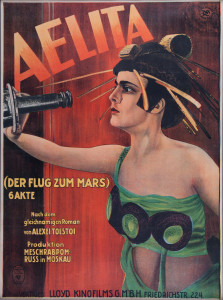 Artwork: P. Grasnick (n.d.). Aelita, 1924
Artwork: P. Grasnick (n.d.). Aelita, 1924
Lithograph on buff woven paper, laid down on canvas. Gift of James T. Van Loo, 2013/2.233
This poster is for the movie Aelita, which is often called the first Soviet science fiction film, created during the sometimes hope-filled beginnings of the Soviet Union. A mysterious radio message is beamed around the world, and among the engineers who receive it are Los, the hero of the film. Aelita is the daughter of Tuskub, the ruler of a totalitarian state on Mars. With a telescope, Aelita is able to watch Los who obsesses about being watched by her. He builds a spaceship and travels to Mars where he is thrown in prison, begins a proletarian uprising and experiences the confusion of reality and fantasy. While Nufonia Must Fall is no sci-fi film, it is based on a graphic novel of the same title, and viewers might find similarities between the genres.
Related performance: Gil Shaham Bach Six Solos
with original films by David Michalek
March 26, 2016
 Artwork: Shitao (Shih-t’ao; Chinese, 1642-1707) Ode on a Wanli-era Imperial Brush Ink on paper, 1705. Museum purchase made possible by the Margaret Watson Parker Art Collection Fund, 1965/2.75.
Artwork: Shitao (Shih-t’ao; Chinese, 1642-1707) Ode on a Wanli-era Imperial Brush Ink on paper, 1705. Museum purchase made possible by the Margaret Watson Parker Art Collection Fund, 1965/2.75.
Taking an honored and beloved corpus of music from the past, Gil Shaham transforms its familiar beauty into a fresh, contemporary work of art. Similarly, Shitao receives a beautiful gift, a porcelain-handled calligraphy brush, from an earlier generation and uses it to write a poem and create a calligraphic masterpiece. The era and form are new but the inspiration is classic.
Related performance: Mariachi Vargas de Tecalitlán
April 1, 2016
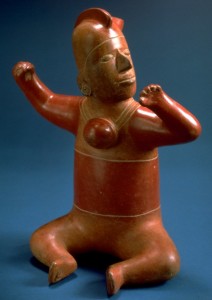 Artwork: Artist Unknown, Mexican, Colima Culture Seated Figure, c. 700 Terracotta Museum purchase made possible by a gift from Helmut Stern, 1983/1.355Artist Unknown, Mexican, Colima CultureSeated Figure, c. 700TerracottaMuseum purchase made possible by a gift from Helmut Stern, 1983/1.355
Artwork: Artist Unknown, Mexican, Colima Culture Seated Figure, c. 700 Terracotta Museum purchase made possible by a gift from Helmut Stern, 1983/1.355Artist Unknown, Mexican, Colima CultureSeated Figure, c. 700TerracottaMuseum purchase made possible by a gift from Helmut Stern, 1983/1.355
This lovely terracotta seated figure is an example of the native arts and culture celebrated by Mexican visual and musical artists. Mariachi Vargas de Tecalitlán transform a regional folk music into a world-class art form.
Related performance: Zafir: Musical Winds from North Africa to Andalucia
April 15, 2016
 Artwork: Artist Unknown, North Africa Qur’an manuscript leaf in Maghribi script, 13th century Ink, red ochre, paper Museum Purchase, 1959/1.146
Artwork: Artist Unknown, North Africa Qur’an manuscript leaf in Maghribi script, 13th century Ink, red ochre, paper Museum Purchase, 1959/1.146
For Muslims, Arabic script, representing the language of the Qur’an, is a thing of sublime beauty. This page is written in a script called Maghribi, a variation of the earlier, angular, Kufic script. Maghribi features sweeping curves that loop across the page and was developed in North Africa and Spain. This Qur’an page combines traditions of the Middle East, Spain and North Africa as does the music of Simon Shaheen and Zafir.
Interested in more? Visit the U-M Museum of Art today.
Tweet Seats: Mariachi Vargas de Tecalitlán
For our second tweet seats event, we saw Mariachi Vargas de Tecalitlán in Hill Auditorium
Meet the participants.
UMS: Tell us a little about you. If you have an online presence you like to share publicly, please tell us the relevant websites or user names/handles.
Matt Landry: I am a K-12 certified music teacher, a University of Michigan graduate, Detroit Symphony Orchestra intern, and saxophonist of the Akropolis Reed Quintet, a five-time national prize-winning classical music ensemble. I tweet from @akropolis5tet, and I help manage the ensemble’s website: www.akropolisquintet.com.
Jared Rawlings: I am a process-centered innovative teacher, and an emerging researcher. I tweet @Jared_Rawlings and my website is: www.jaredrawlings.com.
UMS: In one sentence, how would you describe your relationship with technology?
Matt Landry: I have a love/hate relationship with technology, enjoying its contribution to bettering life while wondering if it is making humans less human.
Jared Rawlings: My relationship with technology is necessary in order to build my personal/professional learning network.
UMS: Why did you decide to participate in this project?
Matt Landry: I decided to participate in order to further deepen this relationship. I wonder if being engaged electronically in a live performance will enhance or detract from the beauty on stage.
Jared Rawlings: I am always looking for new ways to include professional development – on demand.
UMS: To you, what does it mean to “be present” during a performance or another arts experience?
Matt Landry: To be “present” at a performance one must consider what the event will be remembered as. One must comprehend the magnitude of the live performance, clear the mind to listen and/or view, and have a perspective of the event while it is occurring. Looking back on events and their personal significance is important, but doing so at the time of the performance, to me, is being “present.”
Jared Rawlings: Being present means it’s a way of capturing the “lived experience” of the concert goer. Also, given the temporal nature of music, theatre, and dance the tweet seats project is a way of focusing in on this phenomenon that is exclusive to live arts in Ann Arbor.
Meet the tweets.
UMS: How did tweeting affect your experience of the performance; did you expect this effect or are you surprised by this outcome?
Matt Landry:
Jared Rawlings:
Curious about live tweeting during a performance? Sign up.
Photo and Audio Tour of Detroit’s Mexicantown
Editor’s note: The Mariachi Vargas de Tecalitlán return to Ann Arbor on April 1, 2016.
Mariachi Vargas is one of the most highly regarded ensembles in the history of mariachi. Founded in a small city near Jalisco by Don Gaspar Vargas in the 1890s, this band basically invented the modern mariachi, and five generations later, is still playing today.
To explore the music’s connection to our community, we asked WDET’s Martina Guzmán to give us a tour of Detroit’s Mexicantown, a neighborhood with over 100 years of history in the city. Check out the tour below, with images by Detroit-based photographer Erik Howard.
We also visited the LA SED (Latin Americans for Social and Economic Development) Senior Center in the neighborhood, where we heard many stories about the community importance of mariachi music.

“I was born and raised through Mariachis,” Lupe Guzmán says. “Don’t believe what I say, but Mariachi music is like medicine. Mariachi…you have one on side and another Mariachi on the other side, and they make you alive.”

Beatrice Gonzales was a singer when she was younger. She bought the dress in this photo in Mexico 35 years ago. She says that she is still in love with the tradition of Mariachis.

Arnulfo Guiterrez’ favorite song is “El Mariachi Loco.” It’s a LA SED Senior Center favorite for dancing.

UMS thanks AARP for coordinating ticketing and transportation for a group of LA SED seniors to attend the Mariachi Vargas de Tecalitlán performance.
Video: Behind the scenes with Mariachi Vargas at WDET Detroit
Here’s a special behind-the-scenes video of the Mariachi Vargas de Tecalitlan artist residency. Yesterday, Alberto Alfaro (violinist in Mariachi Vargas) accompanied two youth Mariachi singers, Sebastien de la Cruz and Karenn Lazo (both were winners in the 2009 Mariachi Vargas Extravaganza Competition) on the Craig Fahle radio show on WDET 101.9 FM Detroit. Sebastien and Karenn will sing this morning at Hil Auditorium in a special youth performance for K-12 students from Southeastern Michigan. I highly recommend scanning forward to about 1:30 in the video to hear Sebastien sing — he’s amazing! Also, don’t miss Karenn’s performance at the end of the video, which is equally stunning.



